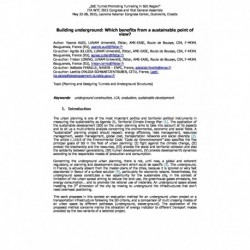Cart
0
0
No document
0,00 €
Total
Document successfully added to your shopping cart
Quantity
Total
There are 0 items in your cart.
There is 1 item in your cart.
Total documents
Total shipping
To be determined
Total
Search & filter
Search for a publication
Search & filter
Building underground: Which benefits from a sustainable point of view?
wtc2015_full_audi-1
L. d’Aloia Schwartzentruber / Y. Audi / A. Jullien / T. Lorino / A. Feraille
The urban planning is one of the most important politics and territorial political instruments in measuring the sustainability as Agenda 21, Territorial Climate Energy Plan . The application of the sustainable development (SD) on the urban planning aims to take into account all its aspects and to sit up a multi-criteria analysis concerning the environmental, economic and social fields. A “sustainable” planning project should respect: energy efficiency, risks management, resources management, waste management, global cost, transportation networks and social diversity The article L.110.0 of the Environmental Code “Code de l’environnement” also specifies the five principal goals of SD in the field of urban planning: (I) fight against the climate change, (II) protect the biodiversity and the resources, (III) provide the social and territorial cohesion and also the solidarity between generations, (IV) human development, (V) provide development’s dynamics according to the responsible modes of production and consumption. Concerning the underground urban planning, there is not, until now, a global and coherent regulatory, or planning and development document which could be specific. The underground, in France, is actually absent from the master-plans of the cities, because it is ignored or very fast abandoned in favour of a surface solution , particularly for economic raisons. Nevertheless, the underground space constitutes a real opportunity for the sustainable city, in the context of limitation of the urban sprawl aiming to reduce the land-use, the greenhouse gases emissions, the energy consumption… and to promote the rational use of materials. An underground space allows investing the 3 dimension of the city by moving to underground the infrastructures that don’t need overhead positioning. This work proposes in this context an evaluation method for an underground urban project or a transportation infrastructure following the SD criteria, and a comparison of multi crossing modes of an urban space by different pathways (underground, above-ground). The application of the proposed method concerns mainly the allocation of energy indicator to different transport modes provided by the two variants of a selected project.




